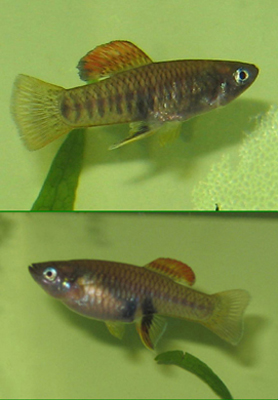|
Select Aquatics of
Erie, CO. |
|
|
|
|
|
| |
|
Livebearers use
internal fertilization,
and many poeciliid livebearers are
easily sexed by the presence of a
gonopodium (Top). The female shows
a gravid spot that becomes larger
and enhanced before she is about
to give birth. (Bottom) Both can
be seen easily in these
Brachyrhaphis roseni. |
 |
|
|
|
Goodeids are the only truly viviparous
fishes, similar to mammals in that the
young are nourished during gestation
by the mother. The males are generally
more strongly marked, and possess
an andropodium.(Pictured below).
These are Skiffia multipunctata. |
|
|
Water movement, aeration, water changes, not overcrowding and
abundant quality food ensure your best
chance of success. Feeding live and frozen foods,
earthworms or a quality earthworm flake in particular,
seems to increase both the size and health of the
broods. Baby brine shrimp is good, but many adults cannot
feed completely on it, so I do not depend on it for
adult fish. Daphnia is excellent, adult Brine shrimp (frozen
works well), white worms, etc. are all good. Feed at
least twice per day, ensuring the tank stays reasonably
clean. Mulm must be removed when it accumulates- heavy
filtration or water changes do not
eliminate its
negative effect on the fish- it is not "inert".
Inedible, decaying organic material is never good for the fish or
the fry. Not only do these practices lead to healthier
fry, but frequent feeding helps ensure that new fry are
not immediately gobbled up if a female drops before you
are able to remove her. A good diet before a drop
helps guarantee robust, vigorous fry. A poor diet can
lead to fry that are born dead, or that die shortly after
birth, or that develop air bladder problems during
their initial development. (“Belly sliders”) |
 |
|
|
| |
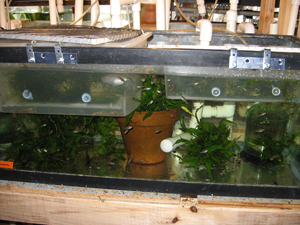 |
|
|
| |
Homemade breeder traps made by cutting out
sides of shoebox style plastic containers, then
covering with polyester mesh is less stressful
for the mother and safe for the fry, who grow out
in the same water they were born in. |
|
|
|
Breeding traps do not work for most swordtails. The traps are
too small, and the female is often distressed
by her lack of movement (particularly when
Java moss is
also added so that babies have a place to hide)
that she may drop early, releasing her fry in an
undeveloped condition, where only a few, if any survive.
Or she will become unable to drop until she becomes
huge, and then she dies- before releasing the young.
A female that is gravid (she is large, and her black
“gravid spot” just behind the belly has become dark)
needs to be moved into a small tank of her own
with some aeration, filled
with fine leaved plants, but not
so much that she cannot swim around. The tank must be at the
temperature of her original
tank,
and filtration (possibly through heavy daily water changes)
is essential. Dirty water compromises
the survival of the new fry. Gestation for most
swords, mollies, platies and guppies is about 25-40 days,
depending on temperature.
Goodeid gestation is about 60 days.
One solution that does work has been to create breeders from plastic
"shoebox" style containers or larger
plastic storage boxes that are small enough to sit within a larger
aquarium. The sides and bottom are cut out,
then covered with fine nylon mesh, glued in with a waterproof
glue. When those are used, be sure to glue a couple
marbles to
the side of the breeder that will face against the aquarium glass, to
prevent smaller fish in the tank from
which can cause a loss
of fish. |
 |
|
|
| |
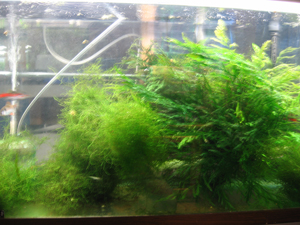 |
|
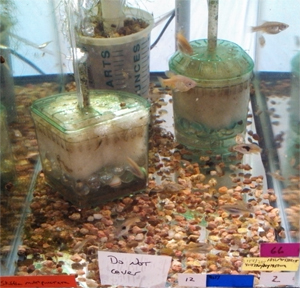 |
|
|
|
Java Moss- the best for fry to hide
in. |
|
|
An ideal tank setup for growing out fry. |
|
|
New fry should be fed newly hatched baby brine shrimp, but can
be raised on an artemia substitute or
other fine dry foods. For
swordtails, guppies,
mollies and platies, fry can be raised slightly warmer
(78-80 degrees) to assist their growth.
Goodeid fry should be raised at cooler
temps- 72-75 that the
adults prefer. Fry
also need to be fed 2-4 times per day at first with daily
water changes of 50%, unless
in a container with adequate
filtration, or in a breeder that sits
within a larger body of water. Leave some
Java moss in with
the fry to assist water quality, but not so much that you cannot see all
of the fry easily to
monitor their condition, or that cause decaying food to
become trapped. Add aeration with at least a mild
air flow from an airstone if possible. Baby brine shrimp and/or the high
protein fry foods foul the water
quickly, and go bad within just a few hours. A quick
ammonia spike will kill new fry fairly quickly. A rule
that I have discovered over many years, and that
seemingly makes little sense, is that fish that cannot be
seen and monitored inevitably suffer losses, whereas
fish that can be watched and kept an eye on will do
better. I know it doesn't make sense, but we all tend to neglect tanks, just enough, that we
are not able to
follow closely.
After 3-6 weeks (depending on species) the
fry can be released in with
the adults. Feed the adults well,
then release just a couple new fry into the tank, watching to see if
they get chased such that they could be
eaten. All adults will chase a new fish to check it out, but when they
determine the other fish is too large
to eat, they will back off. If the adults don't back off, rescue the
released young and wait another week.
|
 |
|
|
|
|
|
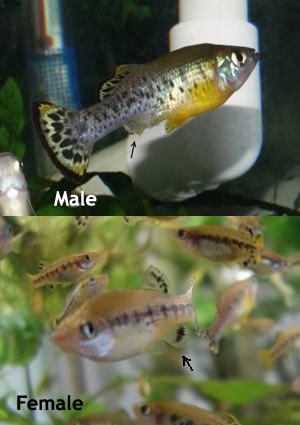 |
Goodeids do not have a gonopodium,
the males instead possess an
andropodium, seen as a notch in
the anal fin of the male. (Arrow in
top pic.) Females posses a normal
anal fin. (Arrow in bottom pic.)
Unlike other poeciliids, goodeids
have a 60 day gestation period,
and females do not store sperm,
so each brood requires a new
fertilization. Goodeid fry are
fewer in number, but much larger
than other livebearer fry. |
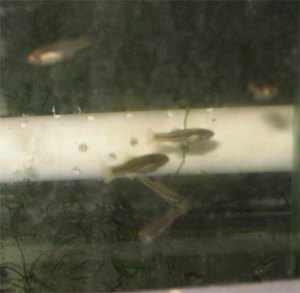 |
|
|
|
|
These Ilyodon furcidens fry are only
1 day old.They are in front of 1/2
inch diameter PVC pipe. these are
just about the largest livebearer
fry there is. |
|
|
The Goodeids- These fish can be the easiest to breed, but building up
their numbers can be a long process
interrupted by long periods of fish not becoming gravid. Some species
will take a break from breeding from
approximately mid September to April, their gestation is around 60 days,
and a young female having her first
batch of fry may only drop 4 or 5 babies. Though the fry are large,
having been nourished by the mother in
utero similar to mammals, they are still often eaten by the adults. The
hiatus some species will take from
breeding over the winter may be triggered by exposure to natural
day-night seasonal light cycles, and
friends with fishrooms without windows, where they can control the light
periods, tell me they generally don't
experience seasonal breeding fluctuations.
Many goodeids
do not
eat their young, but the gravid
females of some species do not do well when
moved to drop their fry. Occasionally after being moved a female
will simply drop her brood stillborn.
I have found that the home-made breeders mentioned earlier will work
when hung in the tank where the
female resides otherwise. Often I simply watch gravid females, then I
will save as many new fry as I can
when born to raise them separately until they are large enough to fare on their own.
|
 |
|
|
| |
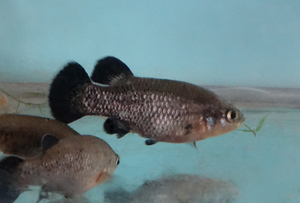 |
|
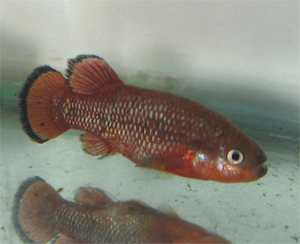 |
|
|
| |
|
The Goodeids are some of the most attractive aquarium fish,
while also extremely rare in the wild.
The pic on the left is a male Characodon audax (and the
andropodium can be clearly seen), and on the
right is a male Characodon lateralis. |
 |
|
|
|
With
Z. tequila the females can be moved reasonably well, but definitely
do best in their own 5 or 10 gallon
to have their fry with lots of Java moss (or fern). Moving to an
unfiltered (but with plants) 2 gallon container
or a breeder can result in the death of the gravid female. Other adults
will eat the fry, and when allowed to
community breed (where
young are simply not removed, with hope that
the population will increase over
time) my experience has been that their numbers will generally decline
over time, rather than increase in
numbers.
Skiffia multipunctata are not big
fry eaters, and I both remove females
on some tanks and leave them in
others if the tank is well planted.
Raising fry separately is critical as fry will continue to die out or
not grow
to their potential, as they do not have equal access
to food and are constantly hiding to protect themselves.
Characodon lateralis will increase in numbers when kept simply as a
community, but will be occasionally
eaten. Their broods are often only 5-10 young, and the new fry generally
do not fare well when left to grow
out in an adult tank. However, the females tolerate being moved, and the
young do well when raised up
separately.
The Goodeids will grow out fairly evenly when well fed, but that is not
the case with the Swordtails.
Most swordtail species have an anomoly where occasional males are born
that reach sexual maturity far
earlier than their siblings, an evolutionary tactic that allows some
males to gain access sexually to the
females before the other males in the tank, producing other early
maturing males in the process. The
problem is that these males will be dramatically undersized, often with
poor color and traits that are
not positive for the line. The only solution, until the line is
stabilized (in that the appearance of early
maturing males is rare or nearly nonexistent), is to raise the sexes
separately, then select for the
largest, most robust fish, culling any early maturing males as
soon as they appear.
With the X. nezahualcoyotl, I had achieved the point when intensively
selectively breeding them
(1997-2000) achieved where the majority grew out evenly. However, I had
stopped working with them
after releasing them into the hobby. I obtained them again about 3 years
ago, and found that the process
of culling the smaller males had to be begun again. Females do not seem
to be as prone to this
characteristic, requiring only that they be watched to choose the
largest, healthiest fish as breeders,
as would be done with any other line of fish.
The Gambusia and Brachrhaphis species- Though not carried by
Select Aquatics, most Gambusia,
Brachyrhaphis, and some wild Xiphophorus will eat their fry
routinely- such that their cannabalism
is a big obstacle to raising and breeding them. The
Brachyrhaphis pictured above is this way-
I have seen 3 week old fry gobbled up enthusiastically by the
adults. The Gambusia are possibly the
worst, and building their numbers requires that gravid females
be be moved to a 10 gallon tank of
their own with generous amounts of java fern and moss. She must
then be watched closely, and removed
as soon as the young are dropped. The young are then raised
separately for at least a month before
being introduced to the adult tank. Efforts to increase the
protein content of their diet, a practice
that can reduce fry eating in other species, seems to have no
effect.
Greg Sage
selectaquatics.com
selectaquatics@gmail.com Copyright
2013
Back to Downloads Page |
 |
|
|
|
|
|
|
|
|
|
|
|
|
|
|
|
|
|
|
|
|
|
|
|
|
|
|
